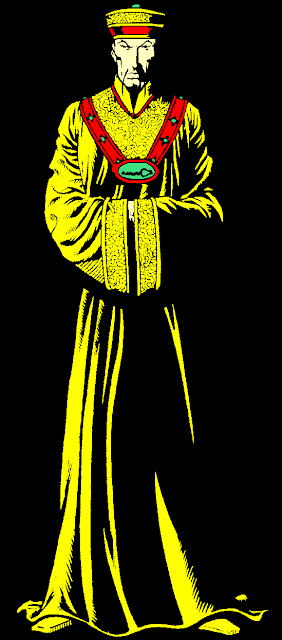It has been questioned whether any evidence exists that suggests those adventures detailed in the Deadly Hands of Kung Fu series take place in the same Earth-616 timeline as those events chronicled in the Master of Kung Fu series.
 |
| by Jim Starlin (digitally remastered) |
DHOKF #1
There is a note from Editor, Roy Thomas,
"* As seen in our color book Master of Kung Fu." Additionally, this issue contains a reprint of SME #15.
DHOKF #4
There's a Pepsi Cola advertisement:
"You've Got a Lot to Live. Pepsi's Got a Lot to Give." That ad campaign ran from 1969 to 1973. This information seems to confirm the placement of this issue within the established chronology.
DHOKF #7
The "Midnight Slasher" returns to face Shang-Chi in Marvel Comic Presents #156, 157, 158.
DHOKF #9
I've located information that allows us to date the events detailed in this issue as occurring before Sunday, March 17, 1974. This information seems to confirm the placement of this issue within the established chronology to some degree of certainty.
DHOKF #11
Smith and Tarr make an appearance. A flashback, detailed in this issue, is stated to have occurred three years ago. This fits the established chronology.
DHOKF #14
Unexpectedly Shang-Chi and Tarr meet.
DHOKF #15
This issue contains a reprint of SME #16.
DHOKF #16
It is explained that Smith has sent Tarr after the Golden Dragon.
DHOKF #17
Tarr remains involved. Smith appears as a hallucination and speaks of the "dirty road", a phrase used in the MOKF series. Petrie appears as a hallucination and speaks of Shang-Chi's inner turmoil concerning his intent to kill Petrie and the guilt he still carries from having believed he had succeeded, an event from SME #15.
DHOKF #18
Tarr remains involved.
DHOKF #29
As he walks through a maze, Shang-Chi recalls a previous adventure in which he was forced to navigate a maze designed by Fu Manchu. There is a note from the Editor-in-Chief, John Warner, "* Giant-Size Master of Kung Fu #2."
Unexpectedly, Shang-Chi and Iron Fist meet. It is clear they know each other. Furthermore, there is a note that explicitly states, "Shang-Chi and Iron Fist have met previously in our color Master of Kung Fu Annual."
DHOKF SAE #1
Smith and Tarr make an appearance.
MOKF ANNUAL #1
This is the first meeting of Shang-Chi and Iron Fist as referenced by DHOKF #29.
MOKF
To the best of my knowledge, none of the issues in the MOKF series references events from or issues of the DHOKF series. I have not checked each issue. At this point, I don't think it is absolutely necessary.
Marvel Database Wiki
3MAC Theory and Chronology
Furthermore, the
3MAC Theory would be less convincing without integrating the two titles. Without the Deadly Hands of Kung Fu series, it would have been a bit more difficult to establish the
chronology. Certainly, the chronology is far more accurate for having properly integrated both titles.
Marvel Universe
I'm not much of an expert on the Marvel Universe or comics in general. MOKF and DHOKF are about the only comics that I've genuinely read or collected. However, the available information seems to suggest there must be a connection between the two titles.
MOKF Universe vs Marvel Universe
Regardless, far as I'm concerned, there's only the Shang-Chi MOKF/DHOKF Universe and it's nearly isolated, as it should be, from the Marvel Universe. The Marvel Universe has ties to Shang-Chi, but his ties to it are a bit more tenuous. All appearances of the character in other titles and team-ups probably should not be included in any "Shang-Chi Canon", particularly many of his more recent appearances.
From my perspective, such appearances are "Marvel's" Shang-Chi in the "Marvel Universe". That character is not necessarily the "original and authentic" Shang-Chi in "his" universe. While there may be a market for that sort of thing, it's an abusive and tragic misuse of the character. By the way, placing Shang-Chi in any environment with "super-powered" individuals could never constitute prudent use of the character. Unless the goals are exposure, marketing, and profit, that is.
Wold Newton Universe
On the other hand, I love the idea of
placing Shang-Chi in the
Wold Newton Universe and would prefer to see him there, rather than in the Marvel Universe. The
"Shang-Chi Universe" is closer kindred to the worlds of Sax Rohmer, Arthur Conan Doyle, and Ian Fleming than to other, shall we say, more imaginative environments.
'Nuff said!








